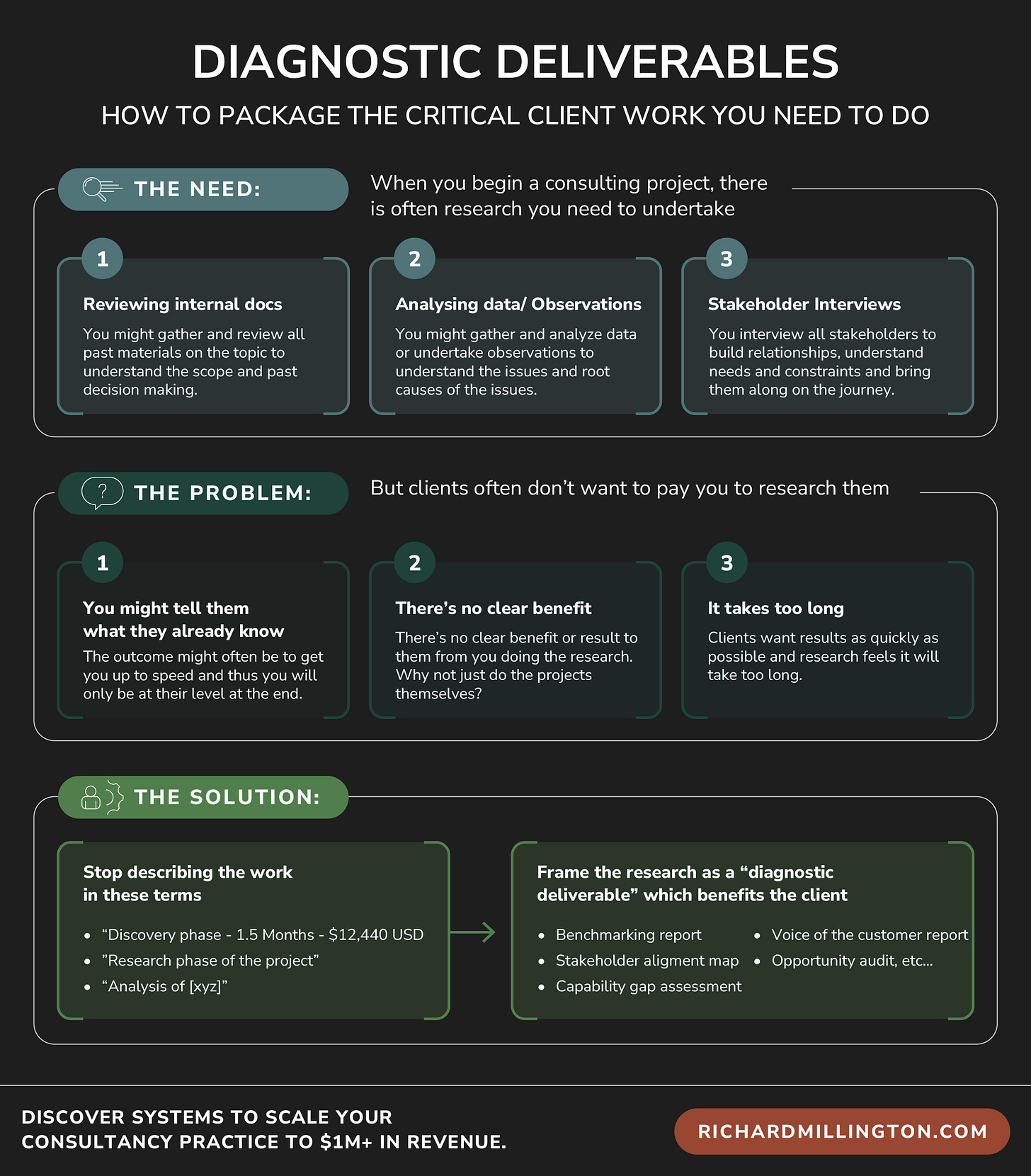Diagnostic Deliverables: How To Package The Discovery Work You Have To Do
Would you hire and pay someone thousands of dollars to research your business? Probably not, this is where the concept of 'diagnostic deliverables' comes into play.
Hi, I’m Rich. Welcome to my weekly newsletter where I share systems and frameworks for scaling your consulting practice from $0 to $1m+ in revenue.
You can get 1:1 personal coaching or explore my course: Proposal Mastery: Learn To Write Winning Business Proposals.
Clients Don’t Want To Pay For You To Research Them
It’s pretty standard for a consultant to start a project by getting up to speed on the client.
Sure, there are things you need to do in the sales process, and you should already have answers to some of the simpler questions.
But when you get started on a project, there is more information you need. This means you need to do a lot of research. This usually means:
Reviewing internal documentation.
Gaining access to data and processing the data.
Undertaking stakeholder interviews. etc…
The last of these, the stakeholder interviews, is usually the most important.
If you don’t do the research, you risk telling clients what they already know, proposing solutions a client is unable to implement, or proposing solutions which aren’t supported.
But here’s the problem.
This process takes time. And it’s time you need to charge for. But it’s a process a client isn’t always willing to pay for.
And you can understand why. The client wants to pay for outcomes, not for you to spend a month learning who they are (I’m being blunt, but this is how clients often perceive it).
The worst thing you can do here is to have a line item in the proposal along the lines of:
Discovery Phase - 1.5 Months - $12,440 USD
It’s vague, it’s time-consuming, and it’s costly. It feels like flab that can be cut.
Also, don’t forget that if you do this well, you will tell the client exactly what they already know.
They just paid to onboard you as an employee. That’s not what anyone wants.
The Language and Packaging Matters
The solution is to package the discovery work into diagnostic deliverables that the client eagerly wants to see.
Don’t use words like ‘research’, ‘discovery’, and ‘analysis’. Instead, translate these into deliverables which the client will want.
For example, this might include:
Benchmarking Report
Interview internal stakeholders to understand current practices, workflows, and KPIs. Compare against industry standards or top performers. This will reveals how the client stacks up and where the biggest performance gaps or competitive weaknesses lie.Stakeholder Alignment Map
Conduct interviews across leadership, product, marketing, and operations to identify conflicting priorities and perspectives. Then visualise internal misalignments and provide a path to build consensus.Capability Gap Assessment
Interview team leads to assess current systems, skills, and capacity against what’s needed to achieve stated goals. Identify where upskilling, restructuring, or new tools are required.Strategic Positioning Snapshot
Explore internal views on brand, market, and customer perceptions through interviews with cross-functional stakeholders. Surface disconnects in brand identity and market messaging that hinder growth.Voice of the Customer Report
Synthesise insights from internal stakeholders who interface with customers, support, sales, community, CX, etc. Highlight recurring customer themes and unmet needs from those closest to them.Opportunity Audit
Use interviews to uncover overlooked assets, initiatives stuck in limbo, or high-potential ideas lacking internal momentum. Help leadership focus energy on the biggest untapped opportunities.
You get the idea.
You’re still conducting the same research, but now you’re structuring it into a diagnostic deliverable that the client will want and appreciate, and for which they will be willing to pay.
The other benefit of this is that it focuses your mind on why you’re doing the research and analysis.
What is the outcome?
What will you need to present?
What will be valuable for the client (what don’t they already know?)
And you might also be able to stop wasting time with questions and analyses, which, while interesting, don’t quite achieve what you want to achieve.
Diagnostic Deliverables Become The Bedrock For Future Work
The best thing about most diagnostic deliverables is that they become a measure for evaluating the success of your consultancy and a means of attracting repeat business from past clients.
We’ve had clients that we benchmark (using our benchmark methodology) every year, allowing them to track their progress over time. The fee for this is around $ 10k, and it doesn’t require too much work to complete.
By providing a grading system, we can also highlight future projects they can take on (and which we can often help with), which will help them improve this ranking.
When thinking about the diagnostic deliverables, think about something that might make sense for an organisation to do once a year.
Good luck!
Connect with Rich
Are you new to the newsletter? Subscribe for free
Follow me on LinkedIn for more insights
Learn to write persuasive business proposals with my Proposal Mastery course
Get 1 to 1 personal coaching. Get a personal coach to help you grow your consultancy practice. Tackle topics like positioning, client acquisition, delivering exceptional value, industry leaderships, and building the systems to thrive. Hit reply or learn more about my coaching approach


